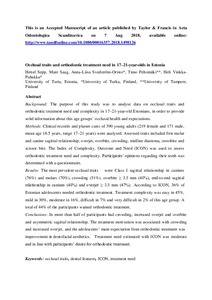Occlusal traits, orthodontic treatment need and treatment complexity among untreated 17–21-year-olds in Estonia
Sepp H.; Saag M.; Peltomäki T.; Vinkka-Puhakka H.; Svedström-Oristo A.
https://urn.fi/URN:NBN:fi-fe2021042719744
Tiivistelmä
Objective: To analyze data on occlusal traits, orthodontic treatment need and treatment complexity in orthodontically untreated 17–21-year-old Estonians.
Materials and methods: Clinical records and plaster casts of 390 untreated young adults (219 females and 171 males, mean age 18.5 years, range 17–21 years) were analyzed. Assessed occlusal traits included first molar and canine sagittal relationship, overjet, overbite, crowding, midline diastema, crossbite and scissor bite. The Index of Complexity, Outcome and Need (ICON) was used to assess orthodontic treatment need and complexity. Participants’ opinions regarding their teeth were determined with a questionnaire.
Results: The most prevalent occlusal traits were Class I sagittal relationship in canines (76%) and molars (70%), crowding (51%), overbite ≥3.5 mm (48%), the end-to-end sagittal relationship in canines (48%) and overjet ≥3.5 mm (47%). Antero-posterior asymmetry was common both in canines (39%) and molars (37%). According to ICON, 36% of participants had orthodontic treatment need.
Conclusions: Desire for orthodontic treatment was associated with crowding and increased overjet, and with no gender difference, participants’ main expectation of treatment was an improvement in dentofacial aesthetics. Treatment needs determined with ICON was moderate and in line with the participants’ desire for orthodontic treatment.
Kokoelmat
- Rinnakkaistallenteet [27094]
